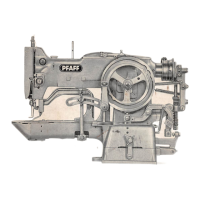.12.
Feeding
the
Material
Since
this machine
has
a rigid
needle
bar
which
does
not swing
sideways,
the
mate
rial is moved
lengthwise
and
across
the
arm to form
the
desired
tack
design.
The
feed
motion is
derived
from
the
feed
cam
and
conveyed
to
work
clamp
D
and
feed
plate E (Fig. 12), between which the work is clamped. Depending on the
subclass
of
the
machine
and
the
nature
of
the
work
to
be
performed,
either
a
standard
or
a
com
pensating
work
clamp
is
used.
The compensating work clamp (shown in Fig. 12) features two feet which yield inde
pendently
against
spring
pressure
so
that
each
foot
exerts
the
same
amount
of
pressure
on
the
material,
it is
used
for
conditions
where
the
material
is
thicker
on
one
side
of
the
needle
than
on
the
other.
Eyelet-end buttonholes look nicer and wear longer if their square end is closed together
before it Is barred. For this purpose the Pfaff 3334-958/01-5
has
been
fitted with a special
work clamp whose feet
are
spread
apart
when they reach the material and then
are
closed showing the fabric together toward the middle. The correct position of the
bar
is
assured
by a guide entering the buttonhole slot. This guide is located
between
the
clamp
feet.
f
mm
R
5797
Fig. 12
13.
Regulating
the
Feed
Across
Motion
The
amount
of
sideways
travel of
the
work
clamp
depends
on
the
design
of
the
tack
and
varies
with
each
subclass.
To
adjust
the
feed
across
motion,
loosen
wing nut F
(Fig. 13)
and
move ball
stud
G in
the
slot
of feed
across
regulator
H,
as
follows:
I
Move
It
toward
you
for
more
sideways
clamp
travel,
or
over
from
you
for
less.
As a
result
of
this
adjustment,
the
stitches
will
be
lengthened
or
packed
more
closely
together,
while
the
total
number
of
stitches
does
not
change.
If
the
stitches
are
placed
too
far
apart,
the
tack
looks ugly. And conversely, if they
are
packed
too
close,
particu
larly In
leather
or
plastic
material,
the
thread
is likely to
cut
through
the
material.
To
facilitate
correct
adjustment,
the
maximum width of
sideways
travel
has
been
limited in
accordance
with
the
style
of
tack
made
by
each
subclass.
Fig. 13

